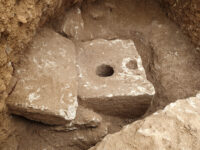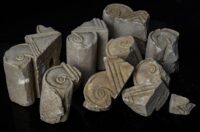 Archaeologists have discovered a rare luxury private toilet in the ruins of a 2,700-year-old royal building from the Kingdom of Judah in Jerusalem. The smooth carved limestone rectangle with a purposeful hole in the center was unearthed in an excavation of the Armon Hanatziv Promenade, formerly the residence of the British governors of Palestine, before construction of a new tourist complex.
Archaeologists have discovered a rare luxury private toilet in the ruins of a 2,700-year-old royal building from the Kingdom of Judah in Jerusalem. The smooth carved limestone rectangle with a purposeful hole in the center was unearthed in an excavation of the Armon Hanatziv Promenade, formerly the residence of the British governors of Palestine, before construction of a new tourist complex.
Only a handful of toilet remains from the First Temple Period have been found in Israel, and most of them have just the toilet seats surviving. This find is exceptional because the seat was discovered inside the original cubicle, an ancient water closet for the most privileged of individuals in an era when permanent toilet facilities (as opposed to commodes or going in a secluded spot outdoors) were communal. Under the hole of the toilet seat was a tank to hold waste. Animals bones and pottery were found inside the tank. Many of the vessels were bowls, so while they may have been discarded as refuse, the preponderance of the bowl form suggests they were used as containers in the bathroom. Deodorant oils to counter the fumes from the septic tank, perhaps?
Archaeologists believe the palace overlooked the Temple Mount was built after the failed Assyrian siege of Jerusalem (701 B.C.) during the reign of King Hezekiah. Two other large-scale royal constructions from around this period have been discovered in Jerusalem, perhaps part of a royal program of reconstruction in the city. The remains of villas and public buildings outside the ancient walls that had stood up to Sennacherib attests to the growth of the city after the Assyrian retreat.
The building and its refined toilet had a short lifespan, alas, destroyed in 586 B.C. when Jerusalem was successfully besieged by the Neo-Babylonian Empire under King Nebuchadnezzar II. The last king, along with most of the societal elite, were deported to Babylonia. Nebuchadnezzar installed a puppet as nominal king, but the destruction of the Temple, the city and its ruling class meant the demise of the Kingdom of Judah.
 Last year excavations unearthed dozens of architectural elements including large column capitals and matching mini-capitals that once topped the palace’s balcony balustrade. The design of the capitals, known as Proto-Aeolian and seen on ancient coins from the period, is characteristic of Kingdom of Judah architecture.
Last year excavations unearthed dozens of architectural elements including large column capitals and matching mini-capitals that once topped the palace’s balcony balustrade. The design of the capitals, known as Proto-Aeolian and seen on ancient coins from the period, is characteristic of Kingdom of Judah architecture.
The bones, pottery and night soil recovered from the septic tank will be analyzed to shed new light on First Temple Period diets, parasites and diseases. Residues inside the bowls may answer the question of whether they were used to deodorize or for some other purpose.